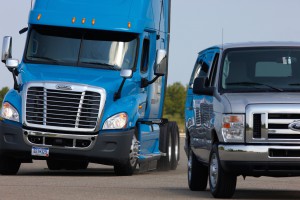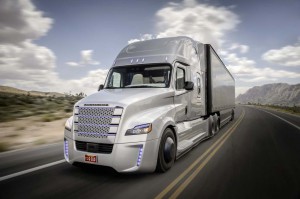
Heavy trucks and buses will be required to have ESC starting in 2017. Manufacturers and suppliers are producing collision mitigation systems already.
The nation’s highways and byways are about to get safer as federal regulators finalized the rules mandating heavy trucks and large buses have electronic stability control systems. The requirement takes effect beginning in 2017.
The systems, known as ESC, have been in use in light vehicles for decades – although not mandated until 2012 – and helps drivers maintain control of the vehicle in situations where spinouts and rollovers are imminent. The effort to get the technology into large trucks began in 2011.
“ESC is a remarkable safety success story, a technology innovation that is already saving lives in passenger cars and light trucks,” Secretary of Transportation Anthony Foxx said. “Requiring ESC on heavy trucks and large buses will bring that safety innovation to the largest vehicles on our highways, increasing safety for drivers and passengers of these vehicles and for all road users.”
Required for Class 7-8 trucks and buses exceeding 26,000 pounds, ESC is expected to prevent 649 injuries and 49 deaths as well as 1,759 crashes annually, according to the National Highway Traffic Safety Administration. The implementation of ESC on these vehicles is also expected to prevent up to 56% of all rollover crashes occurring on roads.
“Last month, NHTSA reported to Congress that truck rollover and passenger ejection were the greatest threats to truck driver safety,” said Dave Osiecki, American Trucking Associations (ATA) executive vice president. “We can save lives by preventing rollovers with electronic stability control technology, and that’s a positive for our industry. Many fleets have already begun voluntarily utilizing this technology and this new requirement will only speed that process.”
The effect of the mandate will be felt quickly. In 2013, large trucks covered 168.4 billion miles in the U.S. and a study by the ATA and IHS Global Insight shows freight tonnage is expected to increase by 23.5% between now and 2025.
(World’s first autonomous truck goes into operation. For more, Click Here.)
The introduction of ESC is just the beginning of technologies aimed at heavy trucks. Manufacturers are following the lead of their automaker cousins and developing and testing autonomous driving technology in trucks as well.
In fact, Freightliner is testing its Inspiration autonomous semi-truck on the roads of Nevada right now. While a human “driver” sits in the driver’s seat in the event of a problem, the truck pilots itself in this phase of testing.
Wolfgang Bernhard, the board member overseeing truck operations at Freightliner’s parent, Daimler AG, said that human error – usually tied to fatigue – accounts for 90% of all accidents involving trucks and autonomous trucks will make the roads safer.
(Click Here for details about saying goodbye to the steering wheel.)
“An autonomous system never gets tired, never gets distracted,” Bernhard said. “It is always on 100%.”
Daimler officials stressed that they have already logged more than 10,000 miles testing the Inspiration truck. Inspiration is what the industry refers to as Level 3 technology, meaning the rig cannot operate under all conditions without driver input. For example, Bernhard noted the truck’s sensors require clearly visible white lane stripes.
Proponents of autonomous vehicles also contend the technology will reduce both fuel consumption and emissions and improve roadway utilization – translating into more cars operating more smoothly on crowded urban roads.
(Google co-founder on the defensive as report of crashes involving self-driving cars hits a dozen. Click Here for the report.)
Nevada was the first state in the country to create special regulations for the use of self-driving vehicles – along with a unique license plate, the bright red tags on the Freightliner rig distinguished by its symbol for infinity. For the time being, the truck will be limited in where it can operate until other states create similar regulations – California and Michigan have been moving forward with similar regulations.


It’s amazing how the Feds come up with expected reductions in deaths and injuries…
What NHTSA and others will soon discover is that it’s a whole lot more difficult to implement ESC on a tractor-trailer than on a car or conventional truck. If done properly it can surely help in emergency braking and on black ice, etc. but it’s a complex deal when working with a trailer in addition to the tractor cab especially when loaded vs. empty weights are considered.